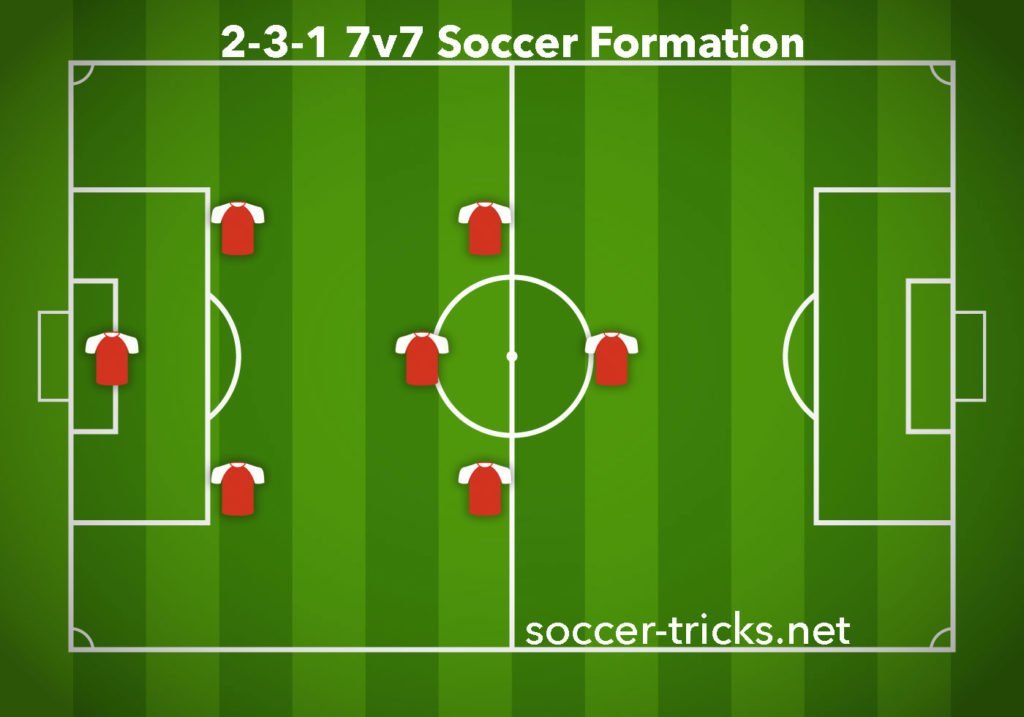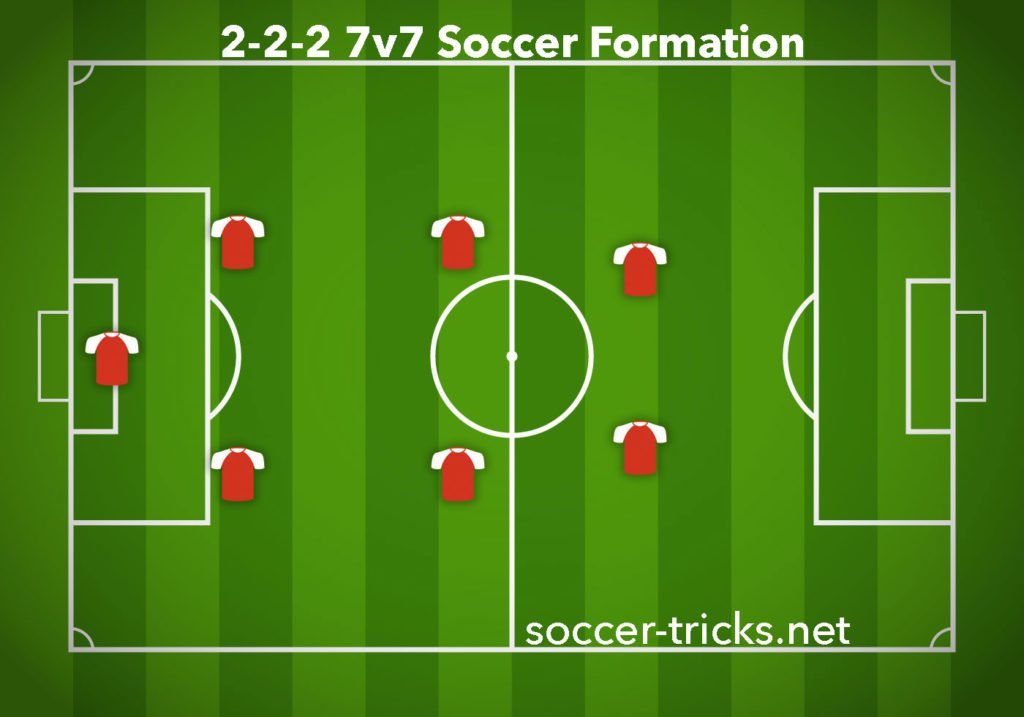7v7
A smaller playing area allows players to practice dribbling skills, develop ball control, and become more familiar with their position on the pitch.
So, what are the best 7v7
7v7
7v7
In this article, I’ll show you 6 of the best 7v7
The 2-3-1 is the most commonly used formation in 7v7
At the same time, the midfielders support the striker upfront and the wide players in midfield can drop back to support the defense.
This 7v7 formation is very well balanced, and allows players to cover many of the areas on the field giving a more fluid and comfortable spacing and responsibilty that most players feel most confident.
Since the formation is so straightforward, young players should be able to understand positioning without problems.
The key to success with this 7v7
Playing a striker that is able to hold the ball and is willing to offer some support will be key to possesion as well as goals.

- With players evenly distributed on the field, this formation is very balanced.
- Players can easily understand each position’s responsibilities since each has a different role to play.
- A good team in this formation will have solid defending, a dangerous attacking threat, and control the possession of the ball.
- Keeping up with the midfielders requires a lot of running.
- Midfielders who stay too narrow and close off each other’s passing angles can get a bit crowded at the center of the pitch.
- Defending too wide can allow gaps to open up behind the defense.
Despite looking very similar to the 2-3-1, the 2-1-2-1 offers a more stable defensive configuration and more attacking capability.
The defensive midfielder allows the other two to be closer to the striker by staying higher up the pitch.
Thus, the three players at the front of the team are assigned attacking roles, while the three players at the back are assigned defensive roles.
Youth players can easily understand the formation which makes it one of the most popular 7v7
The attack can become disjointed if the defensive midfielder does not press forward and the two attacking midfielders fail to track back.
Therefore, even though the midfielders should serve defensively and offensively, they all must understand their responsibilities.
In the absence of better play, there is a danger of them becoming a three-man back and forward. Two of the three will be closer to the lone striker, while the third will primarily focus on defense.

- Each player will know whether they are supposed to be a defensive player or an attacking player.
- There will be lots of goals scored by the team and solid defense.
- The attacking players have considerable freedom in expressing themselves.
- The midfielders will feel almost divided if they cannot work as a group, with one set attacking and the other defending.
- A player’s defensive and attacking spaces can become too wide.
- Playing the system requires a defensively-minded, disciplined player who is adept with the ball.
A 3-1-2 formation may be a good fit if you prefer to play a more defensive formation while maintaining some attacking output.
You will need to have several solid defenders and attackers on your team and one or two hard-working central midfielders.
There may appear to be too much midfield overrun and insufficient width, but players have plenty of options in this formation.
Due to this, attackers and defenders must react quickly and fluidly to situations, pulling wide and dropping back when necessary.
Thus, the 3-1-2 enables them to understand the different responsibilities of their positions and how they can best contribute to the team’s success.

- Strong attack and defense
- Strikers learn to play from the front as well as defend and attack.
- The game teaches players how to position themselves and work as a team.
- If the fullbacks do not push forward, the game can become defensive and narrow.
- To be a successful central midfielder, the player must be very athletic and hard-working.
- Forming an attacking midfield is less effective if the defenders and strikers do not take up positions in a fluid and flexible manner.
As an alternative, you could play in a 3-2-1 formation.
Although this approach is quite defensive, it provides continuity in midfield for the team. In addition, it doesn’t require as much tactical skill or fluidity from the players.
So, you can offer a solid defensive unit and control the midfield while still offering a striker as an attacking threat.
A central defender’s comfort on the ball is vital in this formation, so they can step forward and push into midfield when necessary.
The two midfielders may be confused in the process, as they must provide the team with width and ensure that the center is not left open.
A team must have a hard-working, dynamic midfielder, good defenders, and attackers to make this formation successful.

- The defense is tough to break down with three defenders at the back and two midfielders across the field.
- Possession and dominance in the center of the ground are strengths of the team.
- Unlike other formations, players do not have to be as skilled or quick.
- Strikers isolated upfront can create an overly defensive formation.
- The two midfielders may not be able to widen the field if they don’t push wide.
- Due to the central defender’s role of pushing forward and the midfielders’ covering the center of the pitch and the flanks, this formation can confuse players.
The 3-1-1-1 is another version of the 3-2-1 formation.
However, this formation requires players with the right skills to play it.
Fullbacks should push forward, wingers should float around the pitch, and defensive players should sit behind them.
Although you’ll be able to score while playing this formation, there is some concern that you can’t keep possession because the opposition will overrun your team on the flanks.
Although it’s worth trying this formation out without any wide midfielders if you feel it suits your other players. A solid defensive midfielder, an active attacking midfielder, and fullbacks willing to push ahead are required to play the system.

- Three defenders and a defensive midfielder make up a solid back four.
- Your personnel can make the individual talents of your players stand out.
- A striker and attacking midfielder can be included in the line-up.
- It requires fullbacks to push forward, making it very narrow.
- Players do not pass angles, run, or push wide, it can be difficult to keep possession.
- When the attacking midfielder and striker do not work together as a unit, the team can struggle to create chances.
The 2-2-2 isn’t that common, even though it seems perfectly balanced between defense, midfield, and attack on paper.
However, it can be a fantastic formation to use when played correctly and with the right players. As solid and capable at the back, it risks looking narrow if midfielders or strikers fail to push to the wings.
If players don’t assume various positions or create different passing angles, the team may struggle to control possession.

- In this formation, the defense is solid, and the forwards have attacking options.
- Strikers learn to drop wide and make chances and work as a pair.
- Young players can understand the responsibilities of each position easier when they see what they are expected to do.
- There is a risk of overrunning the flanks.
- Both midfielders and strikers must push out wide to create passing angles, width, and space for passing.
- No one can push the ball wide if you don’t maintain possession.
You can use various 7v7 formations to play any style of
Some formations include more wide players and attackers rather than relying on a defensive solidity at the back.
There is no perfect formation for every situation, so it is a matter of finding the right players, deciding whether to be attacking or defensive, and looking at the opponent.
The best way to keep your players progressing and improving is to test out different 7v7 formations throughout the season. This of course is effective and useful during indoor and offseason exhibition play, giving coaches and players a good feel for a proper 7v7
Sources used for this article: Soccer Coaching Pro
